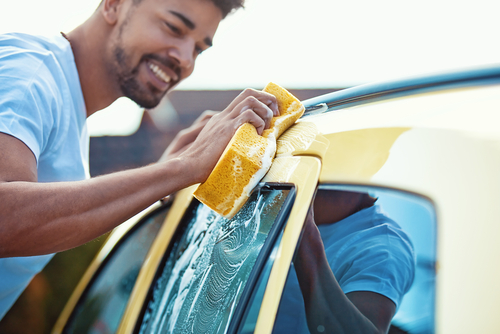Cleaning your car efficiently conserves you time and energy and assures that the vehicle’s body gets out looking excellent. If you wash your vehicle carelessly, the job becomes much longer, and you run the chance of damaging the surface paint, streaking the clear coat, and allowing potential corrosion to set in.

Most of the imperfections that damage your vehicle are likely caused by inadequate washing. Thorough weekly cleaning and careful hand-drying can be the difference between a lasting scratch or scuff. Improper car washing practices will create deformed swirls and damages in the paint which can be difficult to remove at a later date. You can reduce these problems and conserve yourself additional work by developing some easy tips when washing and drying your vehicle. At Mobile Car Detailing Perth we have gone through a few tips to get the best out of your car cleaning efforts.
With mild warmth in the air, several car owners choose to wash their cars at home rather than bring them to a car wash. Before taking out the hose, sponges and containers of water read these car washing tips to have your car obtain a professionally cleaned car.
Below are the tips in washing your car.
1. Preparation
Make sure you have all the necessary equipment with you when you are about to begin washing your vehicle. You don’t want to have to stop mid-wash upon realising you are missing an essential tool. Have a hose, a couple of clean sponges or gloves, a container of water, a bucket to rinse out the sponge and a cloth to dry your car off. Also, make sure to use proper car washing chemicals rather than a house cleaner as these cleaners could damage the car’s protective trims. Be equipped yourself and dress for the part. Wear some shoes you don’t mind getting wet.
2. Wash Your Car Away From Direct Sunlight
Take time in looking for a place with shade. Never wash your vehicle in an area with direct sunlight. This way, you will avoid your car from drying too quick and blemishes from appearing. Even if you utilise the best car shampoo, it won’t protect your car’s paint, plastic and glass from unsightly watermarks, especially if the water is difficult or mineralised with dirt.
3. Pay Attention To Your Car’s Wheel And Tires
Always do them last! If you drag wheel dirt from your wheels onto your vehicle and continue to wash you WILL scratch your car. Use water-based and non-cohesive chemicals. The wheels of your car are the dirtiest part. Be sure to use a separate sponge for washing the wheels from the rest of your vehicle. Use a wheel brush to clean wheels and rims without damaging them. Wash each wheel and tire at a time and remove the detergent entirely before jumping on to the following part.
4. Use Mild Soaps and Lubricants
Clothes or dishwashing liquids are incredibly damaging on a car’s paint, substitutes, and rubber seals. They do not eliminate wax and dirt the same way car detergents do. It’s essential to practice using a car wash that has lubricants. The purpose of the car washing is to eliminate contaminants and grease them, so they do not gain damage to the paint as they slip off the vehicle.
5. Apply The Two-Bucket Method
Load one bucket with soapy water and fill the extra with clean water. Each moment you’re ready to reload your sponge with foamy water, wash it in the clean water first, to wash out the dust and contamination you’ve just eliminated from your vehicle. Then wash it in the soapy water and proceed in cleaning your vehicle.
6. First Remove Big Pieces Of Dirt
Regularly wash and hose your vehicle entirely before you begin cleaning to eliminate big pieces and loosened debris of dirt. Washing your car thoroughly with the hose first is an efficient car wash tip. It’ll help get cleared of any significant bits of dust or debris that could cause damaging and help make cleaning the car more comfortable. Don’t forget to wash between any seals and tail gates.
7. Wash Car In Sections
When starting to clean your vehicle, it’s best to begin the job by section. Begin at the roof and manage your way below. You want to wash the windows and the top panels before cleaning the lower portion of the vehicle you don’t transfer grit to the top half of the car. Rinse and reload your sponge frequently to limit cross-contamination. This process means if any soap drops down, you won’t have to clean the same parts of the car repeatedly. With a clean sponge or mitt, wash the car in back and forth movements rather than winding movements. If you are doing it with a sponge, don’t forget in rinsing separate bucket to prevent the dust from mixing in with the water.
8. Second Rinse
After cleaning your car thoroughly, you want to hose again to get rid of all of the detergent. When washing, use a hose without a nozzle or remove the nozzle from the tube, to let the water run gently under the car in a constant sheeting action. Check around your vehicle to make sure all the detergent is completely off. Keep your washing areas little and wash your wash mitt often in the other bucket. Cleaning your car is almost done!
9. Drying
Use clean drying cloth or synthetic chamois to wipe the excess water off the car. Begin at the top and work downward. If you’re working with a large drying cloth or chamois, toss it out over the smooth exterior areas and gently pull it near you over the outside of the car. Shake and use your drying towel often. Don’t forget to check the hidden areas in drying. Once the surface is usually dry, open the doors and rub-down the frames, beams and seal areas. Dry under the doors or your sills will get wet again as soon as you close the doors. The build-up of water can result in massive staining overtime on related parts can create and cause corrosion and damage. It can also create noticeable watermarks as you drive off.
This has been a guest post by Michael Gallant who is a car cleaning enthusiast and writes for Mobile Car Detailing Perth.

